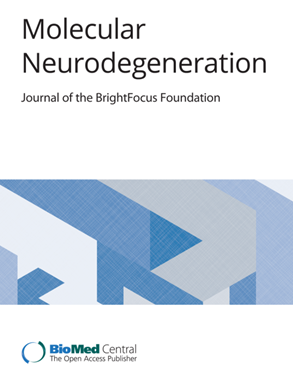LRRK2激酶活性在溶酶体上调节帕金森病相关脂质
IF 17.5
1区 医学
Q1 NEUROSCIENCES
引用次数: 0
摘要
LRRK2的致病变异导致激酶活性增加,LRRK2激酶抑制正在临床研究中作为帕金森病(PD)的治疗方法进行探索。在临床前模型和临床受试者中,LRRK2抑制剂可降低尿中单酰基甘油磷酸(BMP)水平,BMP是参与鞘糖脂(GSL)分解代谢的关键内溶酶体脂质。然而,LRRK2如何调节BMP及其在PD溶酶体功能障碍中的意义尚不清楚。通过结合遗传和药理学方法来调节LRRK2激酶活性,我们探索了LRRK2在细胞模型(包括ipsc衍生的小胶质细胞)以及小鼠组织和生物体液中调节BMP和pd相关GSLs水平的机制。LRRK2活性对溶酶体功能各个方面的影响,包括内溶酶体GCase活性,通过活细胞成像和溶酶体免疫沉淀来评估。我们采用成像质谱法和基于facs的方法专门研究了LRRK2如何调节不同细胞类型和大脑区域的BMP和GSL水平。为了证实我们的发现与疾病的相关性,我们测量了携带与PD风险相关的LRRK2变异的人类受试者和服用LRRK2激酶抑制剂的受试者尿液和脑脊液(CSF)中的溶酶体生物标志物。我们的数据表明,LRRK2可以采用不同的机制来控制细胞内BMP水平,并根据所检查的组织调节溶酶体稳态。我们发现LRRK2的缺失或抑制通过减少含有BMP的囊泡从肾脏分泌到尿液中来降低尿BMP水平。在其他细胞类型中,如小胶质细胞,lrrk2介导的β-葡萄糖脑苷酶(GCase)(一种与pd相关的酶,参与GSL分解代谢)的抑制导致溶酶体GSL积累,并增加BMP水平,作为恢复溶酶体稳态的代偿反应。LRRK2抑制使LRRK2- pd患者的临床前模型和脑脊液中溶酶体功能正常化并降低GSL水平。我们的研究强调了LRRK2激酶抑制改善pd相关溶酶体功能障碍的治疗潜力,并支持GSLs作为LRRK2活性的基于csf的生物标志物的效用。这项工作包括以下PD患者1b期研究的结果:ClinicalTrials.gov ID: NCT03710707;https://clinicaltrials.gov/study/NCT03710707?intr=dnl201&rank=2。注册日期为2018/10/18。本文章由计算机程序翻译,如有差异,请以英文原文为准。
LRRK2 kinase activity regulates Parkinson’s disease-relevant lipids at the lysosome
Pathogenic variants in LRRK2 lead to increased kinase activity, and LRRK2 kinase inhibition is being explored in clinical studies as a therapeutic approach for Parkinson’s Disease (PD). LRRK2 inhibitors reduce urine levels of bis(monoacylglycerol)phosphate (BMP), a key endolysosomal lipid involved in glycosphingolipid (GSL) catabolism, in preclinical models and clinical subjects. However, how LRRK2 regulates BMP and its significance with respect to lysosomal dysfunction in PD are poorly defined. Using a combination of genetic and pharmacological approaches to modulate LRRK2 kinase activity, we explored the mechanisms by which LRRK2 can regulate the levels of BMP and PD-relevant GSLs across cellular models, including iPSC-derived microglia, and in tissues and biofluids from mice using mass spectrometry. The impact of LRRK2 activity on various aspects of lysosomal function, including endolysosomal GCase activity, was assessed using live-cell imaging and lysosomal immunoprecipitation. We employed imaging mass-spectrometry and FACS-based methods to specifically examine how LRRK2 modulates BMP and GSL levels across different cell types and regions of the brain. To confirm the relevance of our findings to disease, we measured lysosomal biomarkers in urine and cerebrospinal fluid (CSF) from human subjects carrying variants in LRRK2 associated with PD risk and from subjects dosed with a LRRK2 kinase inhibitor. Our data demonstrate that LRRK2 can employ distinct mechanisms to control intracellular BMP levels and modulate lysosomal homeostasis depending on the tissue examined. We show that LRRK2 deletion or inhibition lowers urine BMP levels by reducing the secretion of BMP-containing vesicles from kidney into urine. In other cell types such as microglia, LRRK2-mediated inhibition of β-glucocerebrosidase (GCase), a PD-linked enzyme involved in GSL catabolism, leads to lysosomal GSL accumulation and increases BMP levels as a compensatory response to restore lysosomal homeostasis. LRRK2 inhibition normalizes lysosomal function and reduces GSL levels in preclinical models and CSF from LRRK2-PD patients. Our study highlights the therapeutic potential of LRRK2 kinase inhibition to improve PD-associated lysosomal dysfunction and supports the utility of GSLs as CSF-based biomarkers of LRRK2 activity. This work includes results from the following phase 1b study in PD patients: ClinicalTrials.gov ID: NCT03710707; https://clinicaltrials.gov/study/NCT03710707?intr=dnl201&rank=2 . The date of registration was 10/18/2018.
求助全文
通过发布文献求助,成功后即可免费获取论文全文。
去求助
来源期刊

Molecular Neurodegeneration
医学-神经科学
CiteScore
23.00
自引率
4.60%
发文量
78
审稿时长
6-12 weeks
期刊介绍:
Molecular Neurodegeneration, an open-access, peer-reviewed journal, comprehensively covers neurodegeneration research at the molecular and cellular levels.
Neurodegenerative diseases, such as Alzheimer's, Parkinson's, Huntington's, and prion diseases, fall under its purview. These disorders, often linked to advanced aging and characterized by varying degrees of dementia, pose a significant public health concern with the growing aging population. Recent strides in understanding the molecular and cellular mechanisms of these neurodegenerative disorders offer valuable insights into their pathogenesis.
 求助内容:
求助内容: 应助结果提醒方式:
应助结果提醒方式:


